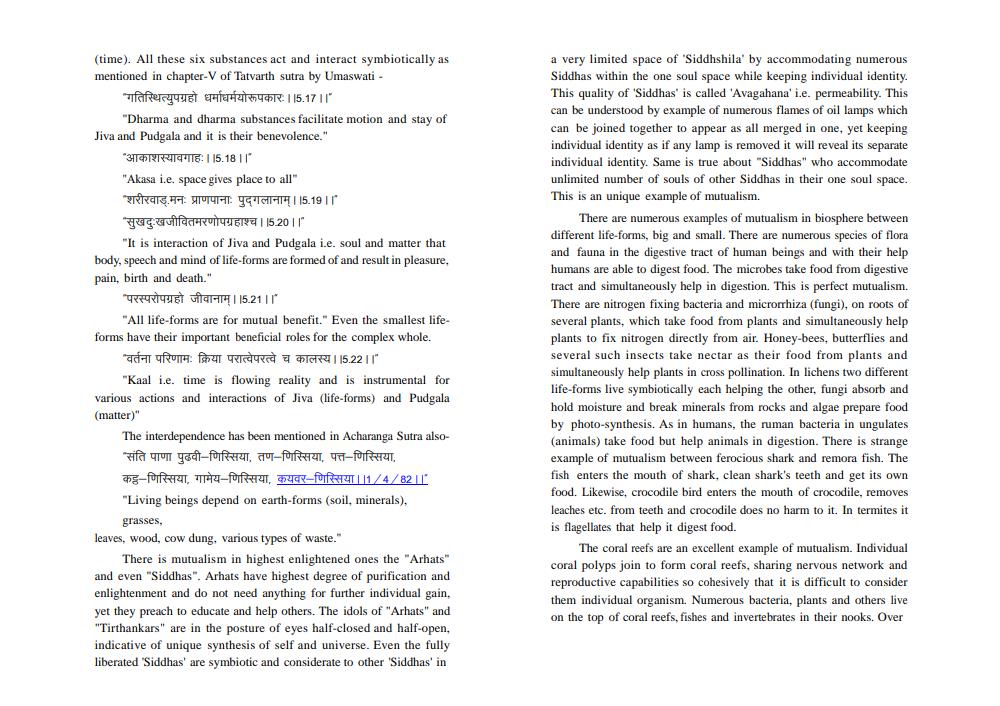________________
(time). All these six substances act and interact symbiotically as mentioned in chapter-V of Tatvarth sutra by Umaswati
"aferuus T 44 R: 115.17 11"
"Dharma and dharma substances facilitate motion and stay of Jiva and Pudgala and it is their benevolence."
*310RR Y TTE: 15.1811" "Akasa i.e. space gives place to all PRE: TTFIT YG HIGHIHI 15.1911
accrofacultura | 152011
"It is interaction of Jiva and Pudgala i.e. soul and matter that body, speech and mind of life-forms are formed of and result in pleasure, pain, birth and death."
"CARII Varra | 15.211
"All life-forms are for mutual benefit." Even the smallest lifeforms have their important beneficial roles for the complex whole.
ad fum: fut ade 15.221"
"Kaal i.e. time is flowing reality and is instrumental for various actions and interactions of Jiva (life-forms) and Pudgala (matter)"
The interdependence has been mentioned in Acharanga Sutra alsowa TT goat-
f , qu-ff121, 49-fore, -fort, 4-for, 442- 11/4/82 II "Living beings depend on earth-forms (soil, minerals),
grasses, leaves, wood, cow dung, various types of waste."
There is mutualism in highest enlightened ones the "Arhats" and even "Siddhas". Arhats have highest degree of purification and enlightenment and do not need anything for further individual gain, yet they preach to educate and help others. The idols of "Arhats" and "Tirthankars" are in the posture of eyes half-closed and half-open, indicative of unique synthesis of self and universe. Even the fully liberated Siddhas' are symbiotic and considerate to other 'Siddhas' in
a very limited space of 'Siddhshila' by accommodating numerous Siddhas within the one soul space while keeping individual identity. This quality of Siddhas' is called 'Avagahana' i.e. permeability. This can be understood by example of numerous flames of oil lamps which can be joined together to appear as all merged in one, yet keeping individual identity as if any lamp is removed it will reveal its separate individual identity. Same is true about "Siddhas" who accommodate unlimited number of souls of other Siddhas in their one soul space. This is an unique example of mutualism.
There are numerous examples of mutualism in biosphere between different life-forms, big and small. There are numerous species of flora and fauna in the digestive tract of human beings and with their help humans are able to digest food. The microbes take food from digestive tract and simultaneously help in digestion. This is perfect mutualism. There are nitrogen fixing bacteria and microrrhiza (fungi), on roots of several plants, which take food from plants and simultaneously help plants to fix nitrogen directly from air. Honey-bees, butterflies and several such insects take nectar as their food from plants and simultaneously help plants in cross pollination. In lichens two different life-forms live symbiotically each helping the other, fungi absorb and hold moisture and break minerals from rocks and algae prepare food by photo-synthesis. As in humans, the ruman bacteria in ungulates (animals) take food but help animals in digestion. There is strange example of mutualism between ferocious shark and remora fish. The fish enters the mouth of shark, clean shark's teeth and get its own food. Likewise, crocodile bird enters the mouth of crocodile, removes leaches etc. from teeth and crocodile does no harm to it. In termites it is flagellates that help it digest food.
The coral reefs are an excellent example of mutualism. Individual coral polyps join to form coral reefs, sharing nervous network and reproductive capabilities so cohesively that it is difficult to consider them individual organism. Numerous bacteria, plants and others live on the top of coral reefs, fishes and invertebrates in their nooks. Over




